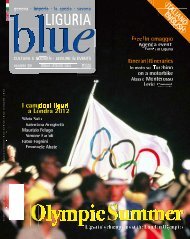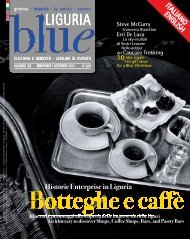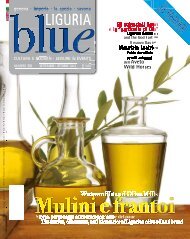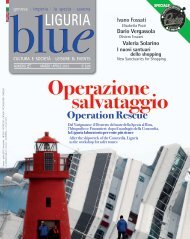Facciamoci sorprendere - Blue Liguria - Sagep
Facciamoci sorprendere - Blue Liguria - Sagep
Facciamoci sorprendere - Blue Liguria - Sagep
Create successful ePaper yourself
Turn your PDF publications into a flip-book with our unique Google optimized e-Paper software.
lue<br />
storie<br />
do, from these two brothers. This bit<br />
of information is published in<br />
Genealogia de Antioquia, a book<br />
which holds the history of every<br />
family of the Colombian province in<br />
which I was born.” This is what<br />
Fernando Botero, tells us. The<br />
famous artist is spending the<br />
summer in Pietrasanta, in his villa<br />
immersed in the greenery on a hill<br />
covered in olive groves under the<br />
sight of a rook that dates to the<br />
Lombard invaders of the Roman<br />
empire. In the workshops of this<br />
town near Versiglia, on the eastern<br />
borders of <strong>Liguria</strong>, Botero founds his<br />
sculptures, and—taken as he is by a<br />
parallel passion for painting which<br />
knows no season and cannot be<br />
abandoned not even for a moment—<br />
spends the rest of the day painting<br />
and setting up seducing new tales on<br />
canvas. The same rite is repeated in<br />
Paris, New York, and Montecarlo, and<br />
namely everywhere he goes, even<br />
during some of his outings at sea in<br />
his personal “boat” which is outfitted<br />
for his needs. But for him, work is<br />
pure entertainment.<br />
In all of these circumstances his<br />
characters take form and substance<br />
characterized by a placid obesity<br />
which affects even the objects<br />
around them, the room that contain<br />
98<br />
Nato a Medellin (Colombia) nel<br />
1932, cresciuto in un’agiata e<br />
colta famiglia cattolica di origine<br />
ligure, Fernando Botero vive tra<br />
Bogotà, New York, Parigi e<br />
Pietrasanta, in Toscana, dove<br />
fonde le sue sculture. Legato alla<br />
tradizione popolare e all’ambiente<br />
tipico dell’America Latina, la sua<br />
pittura si ispira anche al<br />
Rinascimento italiano, conosciuto<br />
e studiato in uno dei suoi primi<br />
viaggi studio in Italia, negli anni<br />
Cinquanta. Sopra, “Tavola da<br />
cucina” (olio su tela, 2002).<br />
Born in Medellin (Colombia) in<br />
1932, and raised in a well-off,<br />
cultured Catholic family of<br />
<strong>Liguria</strong>n origin, Fernando Botero<br />
now resides between Bogotà,<br />
New York, Paris, and Pietrasanta,<br />
in Tuscany, where he casts his<br />
sculptures. With its ties to the<br />
peasant tradition and typical<br />
environment of Latin America, his<br />
painting is also inspired by the<br />
Italian Renaissance, which he saw<br />
and studied during one of his first<br />
study trips to Italy in the fifties.<br />
Above, “Kitchen Table” (oil on<br />
canvas, 2002).<br />
scorre il resto della giornata a disegnare<br />
e a impostare nuovi seducenti racconti<br />
sulla tela. E un simile rito si ripete a Parigi,<br />
a New York, a Montecarlo, ovunque<br />
egli si trovi, magari anche nel corso di<br />
qualche uscita in mare sulla personale<br />
“barca” attrezzata alla bisogna.<br />
In tutte queste circostanze prendono<br />
forma e sostanza i suoi personaggi caratterizzati<br />
da una placida obesità che<br />
coinvolge anche gli oggetti di contorno,<br />
le stanze che li contengono, il paesaggio<br />
che li asseconda. Da un simile connubio<br />
emerge un’armonia edenica che chiama<br />
in causa la nostalgia del tempo e del luogo<br />
smarriti per noi con l’infanzia. Infatti<br />
le sue figure si specchiano in una connotazione<br />
esagerata insita nella tradizione<br />
popolare e nell’ambiente tipici dell’America<br />
Latina e che abbiamo imparato a conoscere<br />
per esempio attraverso i romanzi<br />
di Gabriel García Márquez. Comunque<br />
un simile approccio creativo trova un’ulteriore<br />
giustificazione nella continua ricerca<br />
di un equilibrio formale che riguarda<br />
i volumi e il loro rapporto con lo<br />
spazio, un equilibrio che viene esaltato<br />
nelle sculture allorché il colore viene sostituito<br />
da una sintesi compositiva che<br />
trasferisce il fascino recondito della favola<br />
nella bronzea fissità del mistero. Fissità<br />
di volti ed essenzialità di forme. Così<br />
la sua crescita cognitiva affinatasi a<br />
Firenze nella seconda metà degli anni<br />
Cinquanta a contatto di alcuni capolavori<br />
del Rinascimento nostrano e corroborata<br />
altrove da ulteriori sguardi rivolti<br />
a Vermeer, Rubens, Rembrandt e Velázquez<br />
(tanto per fare alcuni nomi), ha trovato<br />
nella terza dimensione nuovi agganci<br />
che conducono agli egizi, agli<br />
etruschi prima di soffermarsi magari sull’opulenza<br />
di un Maillol. Comunque, alla<br />
fine di ogni percorso indagatore, incontriamo<br />
sempre Botero: grazie a lui lo<br />
sguardo del nostro tempo può nutrirsi di<br />
frutti i cui semi provengono da una cultura<br />
che ci appartiene nell’intimo e continua<br />
ad affascinarci. E poi c’è quell’aggancio<br />
dei due Botero (o Bottero) che<br />
con lui rinnovano l’ideale legame con la<br />
<strong>Liguria</strong>: l’agognato e probabilmente mai<br />
raggiunto filone aureo oggi si specchia e<br />
rinnova l’incanto nelle straordinarie opere<br />
dell’augusto discendente.<br />
them, and the landscapes that back<br />
them up. From a similar marriage<br />
come an Eden-like harmony which<br />
calls to the nostalgia of the times,<br />
and of places lost for us since our<br />
childhood. In fact his figures are<br />
mirrored in an exaggerated<br />
connotation that is inherent in folk<br />
traditions and typical environments<br />
of Latin America, which we have<br />
gotten to known through the novels<br />
of Gabriel García Márquez.<br />
All the same, a similar creative<br />
approach finds yet another<br />
justification in the continual seeking<br />
of a formal equilibrium with respect<br />
to volumes and their relationship<br />
with space, an equilibrium which is<br />
exalted when the sculpture and color<br />
(an element that is narratively and<br />
emotionally important in his<br />
painting) are substituted by a<br />
composition synthesis which<br />
transfers the hidden fascination of<br />
the tale in the bronze fixed by<br />
mystery. Fixed in terms of faces and<br />
essentiality of forms.<br />
In this way his cognitive growth,<br />
refined in Florence in the second half<br />
of the fifties when placed in contact<br />
with some masterpieces of our<br />
Renaissance, and supported<br />
elsewhere by additional glances in<br />
the direction of Vermeer, Rubens,<br />
Rembrandt and Velázquez ( just to<br />
name a few), has also found in the<br />
third dimension new trails leading to<br />
the Egyptians and the Etruscans,<br />
before stopping before the opulence<br />
of a Maillol. All the same, at the end<br />
of every investigative route, we<br />
always find Botero. Thanks to him a<br />
look at our times can be nourished<br />
by the fruits whose seeds come from<br />
a culture which belongs intimately<br />
to us, and which continues to<br />
fascinate us. And then there are<br />
those ties to the two Boteros (or<br />
Botteros) which through him renew<br />
an ideal link to <strong>Liguria</strong>, the coveted<br />
and probably never reached aural<br />
thread that today is mirrored and<br />
renewed by the enchantment of the<br />
extraordinary works of this august<br />
descendent.









